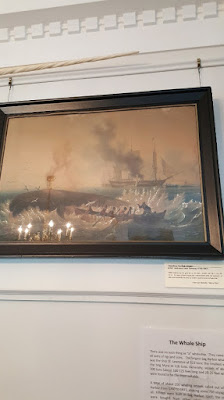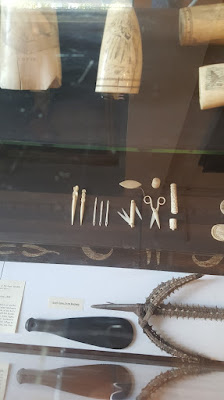Good Ben Huntting
by Gregory Paul
The whaling industry of Sag Harbor has been a keystone to its history and culture. One of the most prominent figures of such is Benjamin Huntting I. Sponsoring the first whaling venture out of Long Island, Huntting is considered the father of Long Island’s whaling operations. Additionally, by the time Long Island’s whaling industry had come to an end, the Huntting family held the record for most sponsored whaling ventures out of Long Island.
Huntting and his partner Stephen Howell helped revolutionize the early whaling industry, not of just Long Island, but of the world. He was the first to suggest the use of try-pots onboard, which greatly increased the efficiency of whaling. Whalers would be able to process whale oil out at sea rather than having to bring back barrels of blubber to be processed on land.
The Huntting House has since been appropriately turned into the Sag Harbor Whaling Museum, which was also designated as a National Treasure by Hillary Clinton in 1998. There is much that can be found on display–a number of whaling ship models, paintings depicting whalers out at sea, trinkets made from whalebone, and genuine scrimshaw! While we were there, sculptures made of garbage found at sea, created by artist Cindy Pease Roe, were strewn about what used to be the Huntting’s living room. I thought her exhibit was very interesting, and there was a clear contrast between Roe’s work and the traditional historical pieces. Tara had also informed me that there were several artifacts that must have been in storage, since she did not see them on display. Considering how interesting the rest of the museum was, I would love to see the artifacts Tara was thinking of some day!
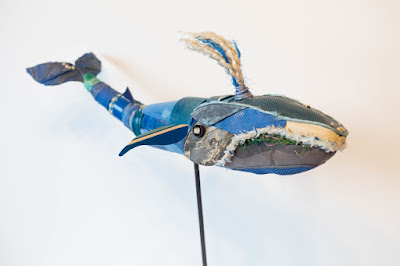 |
| Fig. 3 An example of Roe’s recycled works for her exhibit, Beauty and the Beast |
The Importance of a Deep-Sea Port
by Elaine Alberts
The Sagaponack Harbor commonly known as Sag Harbor is a small town on the Northern shore of the Southern fork of Long Island. Although it is currently regarded as a swanky New England town filled with galleries and boutiques, in the 18th century it was a middle-class town that prided itself on its hard-working residents. Sag Harbor was an essential part of the New York economy, especially in the 19th century, when whaling was in its hay day. This was one of the 4 most important harbors in New York, because it is a deep-sea harbor.
Long Island was formed by glaciers approximately 21,000 years ago. When the glacier receded, it left behind a massive pile of sediment. These mounds of sediment are called moraines; these moraines have soft slopes on the southern edge, and end abruptly on the northern edge. Sag Harbor is on the northern edge of the Ronkonkoma moraine. Sag Harbor is very deep and well protected. The town was destroyed by fires four times, including during the war of 1812, but it was rebuilt every time. Most cities would not have been rebuilt so many times, but the location and importance of Sag Harbor was enough to motivate residents to rebuild. It was more convenient for ships coming from England to sail into Sag Harbor than to go all the way to New York City. Combining all of these factors made Sag Harbor a cosmopolitan hub.
One of the more notable events in Sag Harbor’s history was Meigs raid. In 1777, 90 British were captured by the Patriots without firing a shot. The Patriots had discovered the payday of the British soldiers, they attacked and rounded up the drunken soldiers and sent them to Connecticut as prisoners. Every year, Sag Harbor holds a reenactment of Meigs raid (I’ve heard it is pretty amusing). Another key part of Sag Harbor’s history is whaling. Families like the Huntting family made their fortune by sending ships out to find and kill whales for their oil. The deep waters in the harbor were ideal for whaling vessels to unload their precious cargo. The duration of a whaling venture often varied, ships would not return to the harbor until their hold was filled with oil. The longest voyage out of Sag Harbor was 11 years. During the 18th Century the Navigation Acts called for the building of a custom’s house. The customs house was managed by a man named Henry Dering. The building still exists, and because of the generous donations of the Dering family, almost everything in the house is original. The Huntting family home and the customs house have been moved next to each other and are now used as museums to retell the history of Sag Harbor and the importance of this deep-sea port.
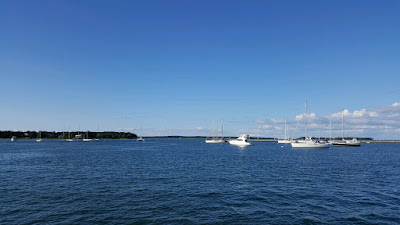 |
| Sag Harbor: A picture of Sag Harbor’s deep-sea port. |
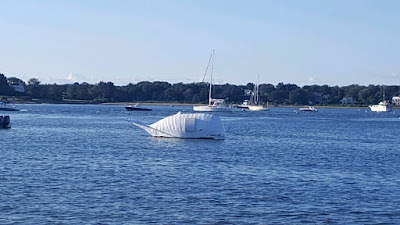 |
| Sag Harbor Whale: A picture of an artificial whale that is “harpooned” every year at the annual Sag Harbor Whaling Festival. |
The Sag Harbor Whaling and Historical Museum
by Zerfana Khan
Sag Harbor was one of the key places to be in during the height of whaling industry in the 19th century. Many families made a living off this industry including the Huntting family who made a substantial fortune. The Huntting family fortune allowed them to obtain all the attributes associated with upper class citizens. This can be demonstrated by viewing their estate. Today we visited their home which has been converted to The Sag Harbor Whaling and Historical Museum, considered to be a National Treasure.
It was very interesting to visit the museum from a architectural and artistic perspective. My first initial look threw me off as it incorporated many Greek architectural features. The corinthian capitals and columns are what stood out the most. The home was built in 1845 by Minard LaFever. Surprising enough, the architect was American from New York. LaFever’s goal was to make the building stand out, displaying the enormous wealth and power of the Huntting family. Furthermore, other elements on the outside included Greek keys, and a triangular pediment with alternating whale tooth and blubber spade figures referring to whaling. In addition, the museum also displayed the jawbone of a whale outside of the frame of the front entrance.
The same idea continued throughout the rest of the museum. The ceiling and doors are detailed with shapes of waves, harpoon looking reliefs, and tails through the use of a sand plaster casting method. The doors were made out of solid wood with carved patterns. And the staircase had an irregular shape, with a beautiful dome shaped skylight. Moreover, it is obvious how well LaFever did in representing the wealth of the Huntting family. The European ornaments he used and be seen in many government buildings.
 |
| Figure 1: Shows the front of the Sag Harbor Whaling and Historical Museum. Here you can see the many Greek architectural elements. |
 |
| Figure 2: Shows the ceiling of the inside if the museum. |
Sag Harbor
by Amanda Dias
On this sunny Friday morning, we jumped in the van and made our way to the beautiful town of Sag Harbor. When we got to the town we split into two groups and went to explore the museum and the Custom house. We learned a lot about the practice of whaling and the impact a maritime culture had on this worldly community.
The Custom House was a very important house back when Sag Harbor was one of New York’s two major ports. The house was owned by the U. S. Custom Master, Henry Packer Dering, who lived there with his family. The house itself was used both as a residence and an office for Mr. Dering. As you walk through this house, that stands a few blocks from its original location it has a very charming look to it. The first room you walk into, that was restored to look as it did when the Derings lived there, is the parlor. The parlor was relatively spacious and had windows that would make it hard for people to look into the room, because not only did they count money inside but they kept some valuables of the towns people as well.
 |
|
Figure 1: A clock in the parlor of the Custom House which was originally owned by the Dering family, the hole in the ceiling even dates back to when they owned the house.
|
As we toured the rest of the house there was a plethora of artifacts from both the Dering family and pieces from the same time period that they lived in the house. The different rooms were filled with different colored wallpapers imported from France. Also during their time in the house there were four rooms with wall to wall carpeting imported from India, even one carpet per household was very uncommon. They had a fairly large kitchen with two pantries stocked with many different gadgets and foods, including a waffle maker and a 100-year-old jar of peaches. Then as we went to the dining room there was a table filled with beautiful imported china. As we moved upstairs we looked at the different bedrooms belonging to the Derings and their children. Which was filled with fun artifacts like a mouse playhouse and indoor bathrooms.
Both museums, while small, were very informative. The guided tours definitely helped you really become immersed in the history. They hold so much of the history of Sag Harbor.
 |
|
Figure 2: Photo of the kitchen with all the different gadgets that would be used for and around the fireplace.
|
Whaling’s History and Influence in Sag Harbor, NY
by John McGee
In the mid 19th century, Sag Harbor, NY was an economic powerhouse and major worldwide port thanks to deep-sea whaling. Whale oil became an essential part of 19th century life, used in everything from soap to lubricants. Its chief purpose, however, was as fuel for lamps. Along with Nantucket and New Bedford, Sag Harbor was a major hub of whaling in America. Whaling vessels would leave the naturally deep, safe harbor and circumnavigate the globe in search of whales. If fortunes were good, a vessel could return to port in as little as 18 months filled to capacity with barrels of liquid gold. A typical trip lasted between 2-4 years, sailing from the North Atlantic, to the waters off East Africa, and even as far as the South Pacific!
For many, deep-sea whaling had extreme pay-offs. Captains, first mates, and those who financed the voyages could all expect to make off handsomely well after a successful voyage. As for the rest of the crew, pay was not fantastic, was it was steady and dependable. But for many young men, whaling offered more than just a paycheck. Whaling offered a world full of promise, never before seen destinations, and exotic women. Many people were born, lived, and died in their hometown without ever leaving. Knowing this, whaling was marketed as a break from the norm, with the chance to see the world and be somebody. Unfortunately, this was not the reality of life on the high seas.
Inexperienced new recruits, known as green hands, had to adapt quickly or risk death. Their quarters were at the bow of the ship, the area most prone to high turbulence and leaking. A steady diet of salted pork, potatoes, and a crunchy shortbread known, as tack could be all a man ate for months on end. This would be washed down with grog, a mixture of 50 parts rum and 50 parts water that used utilized in order to make drinking water consumable on long sea voyages. If a whale was spotted, green hands then got to take part in the hunt, which involved chasing after whale in a 30 foot row boat to harpoon it, tire it out, kill it, and then drag it back to the boat. If a whale was killed and brought back to the vessel, along with the crew, in one piece, the process of stripping the whale for its blubber and bones then began. All rendering and processing took place on the deck of the ship. Conditions were extremely dangerous, as blood, oil, wood, waves, knives and fire make the perfect storm for an inexperienced whaler. If injury or disease did occur, a sailor was left to his own devices, with the exception of a small first aid medical kit, in order to get well. No doctors were brought on the vessels, and many perished at sea.
While the marketing promises made to young men in Sag Harbor were often far from the truth, it is understandable how they fell for such ploys. Ships and crews from all over the world came to Sag Harbor to take part in the whale oil trade. In the streets, you could hear people speaking English, Algonquin, Chinese, Portuguese, and many other languages. Crews often employed local Shinnecocks and Montauketts, as well as African Americans. If you were good at whaling, your race was irrelevant at sea. Whaling quickly brought with it an affluence and diversity uncommon to the east end of Long Island. Even today, Sag Harbor is considered much more cosmopolitan than other villages such as Southampton or Easthampton, and diversity has endured as well. Although it has not been practiced for over a century, whaling still continues to influence the day to day life in Sag Harbor.
The Importance of a Deep-Water Port in Sag Harbor
by Genevieve Rappold
“Port of Entries” were set up by George Washington soon after the Revolutionary War to manage imports, exports, immigration, and emigration. Sag Harbor was one of four Port of Entries in New York because it was easier to get to than New York City (another Port of Entry) and because it had a protected port with deep enough water for large ships to enter. Each Port of Entry had a customs house which served as the office and home of the customs master. In Sag Harbor this was the office/home of Henry Packard Dering, a much respected man as he had stayed in the position until his death. Since this town had a fair amount of trade and immigration, Sag Harbor became a cosmopolitan town, full of different kinds of people you couldn’t find anywhere else in the early United States.
The port of Sag Harbor was also the home of a large whaling industry. The whaling industry was so big, in fact, that Benjamin Huntting was able to build a huge house because of his success in the whaling industry. This house was designed with beautiful detail that is reminiscent of a castle. The whaling industry was so lucrative because of the oil that came of it since that oil was needed to keep lamps lit. These whaling ships were very large and would go out for years at a time to fill the ship with oil. It was a very dangerous task that was said “to turn boys into men”. It was this whaling industry that influenced many aspects of the town, such as the detailing that went into Mr. Huntting’s mansion and even today with an annual event where people compete to “harpoon a whale”, or really attach a plunger to a cartoonish man-made whale.



